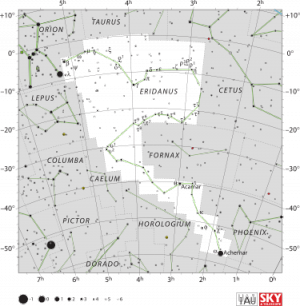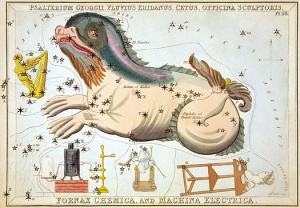Eridanus: Difference between revisions
No edit summary |
No edit summary |
||
| (6 intermediate revisions by the same user not shown) | |||
| Line 1: | Line 1: | ||
[[File:375px-Eridanus IAU.svg.png|thumb|File:375px-Eridanus]] | |||
Eridanus is a constellation. It is represented as a river; its name is the Latin name for the Po River. It was one of the 48 constellations listed by the 2nd century astronomer Ptolemy, and it remains one of the 88 modern constellations. It is the sixth largest of the modern constellations | Eridanus is a constellation. It is represented as a river; its name is the Latin name for the Po River. It was one of the 48 constellations listed by the 2nd century astronomer Ptolemy, and it remains one of the 88 modern constellations. It is the sixth largest of the modern constellations | ||
At its southern end is the magnitude 0.5 star Achernar, designated Alpha Eridani. 144 light-years from Earth, it is a blue-white hued main sequence star whose traditional name means "the river's end".Achernar is a very peculiar star because it is one of the flattest stars known. | At its southern end is the magnitude 0.5 star Achernar, designated Alpha Eridani. 144 light-years from Earth, it is a blue-white hued main sequence star whose traditional name means "the river's end".Achernar is a very peculiar star because it is one of the flattest stars known. | ||
There are several other noteworthy stars in Eridanus, including some double stars. Beta Eridani, traditionally called Cursa, is a blue-white star of magnitude 2.8, 89 light-years from Earth. Its place to the south of Orion's foot gives it its name, which means "the footstool". Theta Eridani, called Acamar, is a binary star with blue-white components, distinguishable in small amateur telescopes and 161 light-years from Earth. The primary is of magnitude 3.2 and the secondary is of magnitude 4.3. 32 Eridani is a binary star 290 light-years from Earth. | There are several other noteworthy stars in Eridanus, including some double stars. Beta Eridani, traditionally called Cursa, is a blue-white star of magnitude 2.8, 89 light-years from Earth. Its place to the south of Orion's foot gives it its name, which means "the footstool". Theta Eridani, called Acamar, is a binary star with blue-white components, distinguishable in small amateur telescopes and 161 light-years from Earth. The primary is of magnitude 3.2 and the secondary is of magnitude 4.3. 32 Eridani is a binary star 290 light-years from Earth. | ||
Epsilon Eridani is a star with one extrasolar planet similar to Jupiter. It is an orange-hued main-sequence star of magnitude 3.7, 10.5 light-years from Earth. Its one planet, with an approximate mass of one Jupiter mass, has a period of 7 years. | Epsilon Eridani is a star with one extrasolar planet similar to Jupiter. It is an orange-hued main-sequence star of magnitude 3.7, 10.5 light-years from Earth. Its one planet, with an approximate mass of one Jupiter mass, has a period of 7 years. | ||
The name Eridanus refers to the Po River, the main river of northern Italy. Its association with a river comes from the way its stars trace a tortuous path. In some star maps, Eridanus is depicted as a river flowing from the waters poured by [[Aquarius]]. In such maps, Aquarius is visualized as facing Eridanus, requiring a different perspective and a redesign of how the stars of Aquarius connect, so the water pours onto the same side as Eridanus. | The name Eridanus refers to the Po River, the main river of northern Italy. Its association with a river comes from the way its stars trace a tortuous path. In some star maps, Eridanus is depicted as a river flowing from the waters poured by [[Aquarius]]. In such maps, Aquarius is visualized as facing Eridanus, requiring a different perspective and a redesign of how the stars of Aquarius connect, so the water pours onto the same side as Eridanus.<ref>[http://en.wikipedia.org/wiki/Eridanus_%28constellation%29 Eridanus]</ref> | ||
==Supervoid== | |||
The Eridanus Supervoid is a large supervoid (an area of the universe devoid ofgalaxies) discovered as of 2007. At a diameter of about one billion light years it is the second largest known void, superseded only by the Giant Void in Canes Venatici. It was discovered by linking a "cold spot" in the cosmic microwave background to an absence of radio galaxies in data of the United States National Radio Astronomy Observatory's Very Large Array Sky Survey.There is some speculation that the void may be due to quantum entanglementbetween our universe and another. | |||
== | ==History and mythology== | ||
[[File:Sidney Hall - Urania's Mirr.jpg|thumb|Cetus feet in Eridanus]] | |||
According to one theory, the Greek constellation takes its name from the Babylonian constellation known as the Star of Eridu (MUL.NUN.KI). Eridu was an ancient city in the extreme south of Babylonia; situated in the marshy regions it was held sacred to the god Enki-Ea who ruled the cosmic domain of the Abyss - a mythical conception of the fresh-water reservoir below the Earth's surface. | |||
Eridanus is connected to the myth of Phaëton, who took over the reins of his father Helios' sky chariot (i.e., the Sun), but didn't have the strength to control it and so veered wildly in different directions, scorching both earth and heaven. Zeus intervened by striking Phaëton dead with a thunderbolt and casting him to earth. The constellation was supposed to be the path Phaëton drove along; in later times, it was considered a path of souls. Since Eridanos was also a Greek name for the Po (Latin Padus), in which the burning body of Phaëton is said by Ovid to have extinguished, the mythic geography of the celestial and earthly Eridanus is complex. | |||
Another association with Eridanus is a series of rivers all around the world. First conflated with the Nile River in Egypt, the constellation was also identified with the Po River in Italy. The stars of the modern constellation Fornax were formerly a part of Eridanu. ERIDANOS was a River-God of the mythical northern land of [[Hyperboreans|Hyperborea]]. He was also the god of the constellation Eridanus. | |||
<ref>[http://en.wikipedia.org/wiki/Eridanus_%28constellation%29 Eridanus]</ref> | |||
==HGS Session References== | ==HGS Session References== | ||
Latest revision as of 00:08, 17 March 2015
Eridanus is a constellation. It is represented as a river; its name is the Latin name for the Po River. It was one of the 48 constellations listed by the 2nd century astronomer Ptolemy, and it remains one of the 88 modern constellations. It is the sixth largest of the modern constellations
At its southern end is the magnitude 0.5 star Achernar, designated Alpha Eridani. 144 light-years from Earth, it is a blue-white hued main sequence star whose traditional name means "the river's end".Achernar is a very peculiar star because it is one of the flattest stars known.
There are several other noteworthy stars in Eridanus, including some double stars. Beta Eridani, traditionally called Cursa, is a blue-white star of magnitude 2.8, 89 light-years from Earth. Its place to the south of Orion's foot gives it its name, which means "the footstool". Theta Eridani, called Acamar, is a binary star with blue-white components, distinguishable in small amateur telescopes and 161 light-years from Earth. The primary is of magnitude 3.2 and the secondary is of magnitude 4.3. 32 Eridani is a binary star 290 light-years from Earth.
Epsilon Eridani is a star with one extrasolar planet similar to Jupiter. It is an orange-hued main-sequence star of magnitude 3.7, 10.5 light-years from Earth. Its one planet, with an approximate mass of one Jupiter mass, has a period of 7 years.
The name Eridanus refers to the Po River, the main river of northern Italy. Its association with a river comes from the way its stars trace a tortuous path. In some star maps, Eridanus is depicted as a river flowing from the waters poured by Aquarius. In such maps, Aquarius is visualized as facing Eridanus, requiring a different perspective and a redesign of how the stars of Aquarius connect, so the water pours onto the same side as Eridanus.[1]
Supervoid
The Eridanus Supervoid is a large supervoid (an area of the universe devoid ofgalaxies) discovered as of 2007. At a diameter of about one billion light years it is the second largest known void, superseded only by the Giant Void in Canes Venatici. It was discovered by linking a "cold spot" in the cosmic microwave background to an absence of radio galaxies in data of the United States National Radio Astronomy Observatory's Very Large Array Sky Survey.There is some speculation that the void may be due to quantum entanglementbetween our universe and another.
History and mythology
According to one theory, the Greek constellation takes its name from the Babylonian constellation known as the Star of Eridu (MUL.NUN.KI). Eridu was an ancient city in the extreme south of Babylonia; situated in the marshy regions it was held sacred to the god Enki-Ea who ruled the cosmic domain of the Abyss - a mythical conception of the fresh-water reservoir below the Earth's surface.
Eridanus is connected to the myth of Phaëton, who took over the reins of his father Helios' sky chariot (i.e., the Sun), but didn't have the strength to control it and so veered wildly in different directions, scorching both earth and heaven. Zeus intervened by striking Phaëton dead with a thunderbolt and casting him to earth. The constellation was supposed to be the path Phaëton drove along; in later times, it was considered a path of souls. Since Eridanos was also a Greek name for the Po (Latin Padus), in which the burning body of Phaëton is said by Ovid to have extinguished, the mythic geography of the celestial and earthly Eridanus is complex.
Another association with Eridanus is a series of rivers all around the world. First conflated with the Nile River in Egypt, the constellation was also identified with the Po River in Italy. The stars of the modern constellation Fornax were formerly a part of Eridanu. ERIDANOS was a River-God of the mythical northern land of Hyperborea. He was also the god of the constellation Eridanus.
HGS Session References
HGS Sessions - Clearing Hyperspace Phantom Matrix - 3/12/2015 [3]
References
Found in HGS Manual on Page 108
Found in HGS Manual on Page 115



